Juvenile Justice Systems: Trial and Punishment of Offenders Debate
VerifiedAdded on 2023/06/10
|10
|2288
|248
Essay
AI Summary
This essay delves into the critical debate surrounding juvenile justice, specifically addressing the question of whether juvenile offenders should be tried and punished in a court of law. It explores the complexities of the Youth Criminal Justice Act (YCJA) and its applicability in Canada, considering the vulnerability of young people and the potential psychological impacts of harsh treatments. The discussion examines various arguments, including the effectiveness of existing laws and the measurement of crime severity, referencing the works of Loeber and Farrington, Courtney, Hook and Lee, and others. The essay analyzes the justifications for punishment, contrasting views on the role of the YCJA in reducing youth incarceration while addressing the increasing crime rates among juveniles. It also presents arguments against trying juveniles as adults, emphasizing rehabilitation and the importance of considering the unique circumstances of young offenders. The ethical considerations in trying juveniles are also addressed, highlighting the influence of mental health and the importance of accountability. The essay concludes by asserting that the differences in treatments based on the severity of the juvenile crime have helped in rectifying the mentalities of the adolescents and thereby decrease the rates of crime among the juveniles.
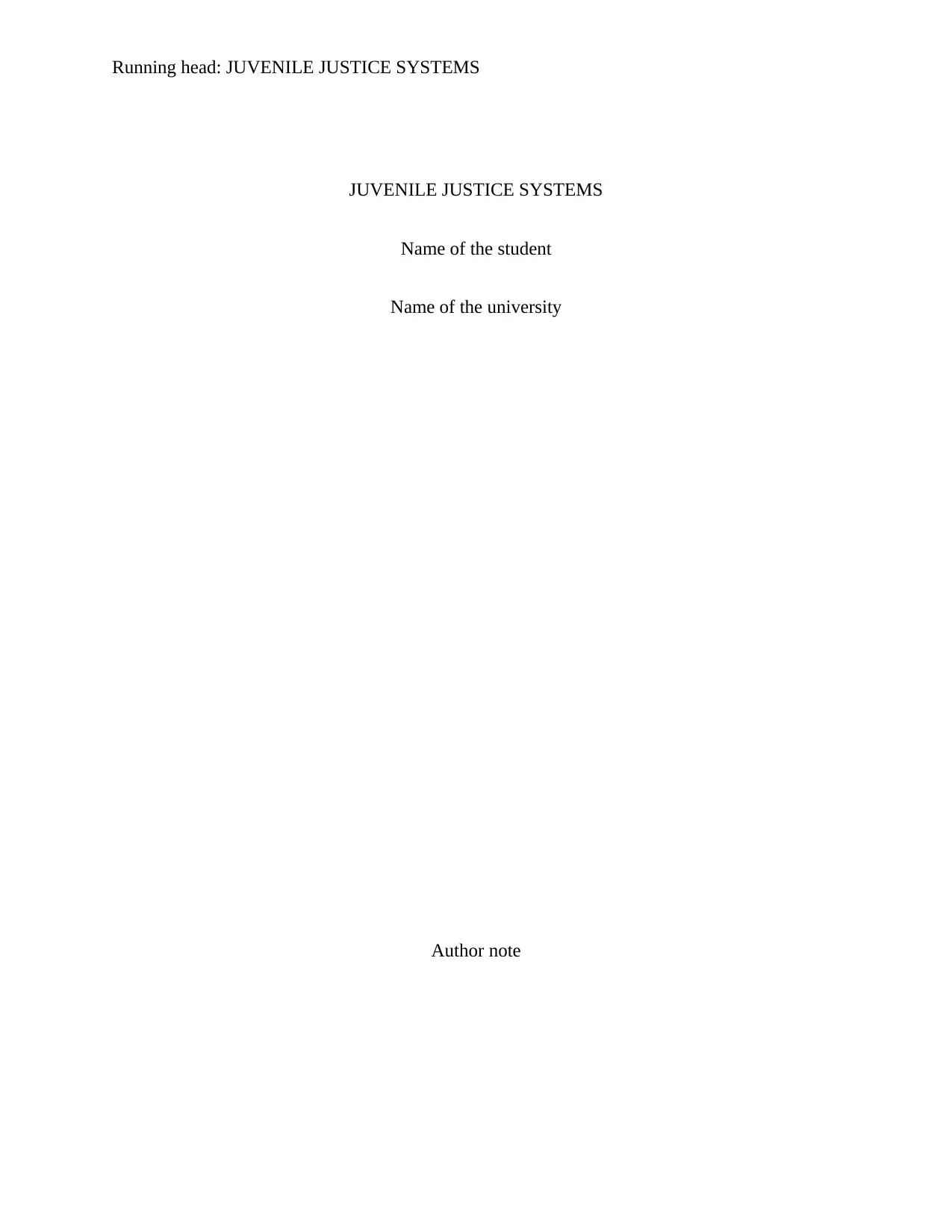
Running head: JUVENILE JUSTICE SYSTEMS
JUVENILE JUSTICE SYSTEMS
Name of the student
Name of the university
Author note
JUVENILE JUSTICE SYSTEMS
Name of the student
Name of the university
Author note
Paraphrase This Document
Need a fresh take? Get an instant paraphrase of this document with our AI Paraphraser
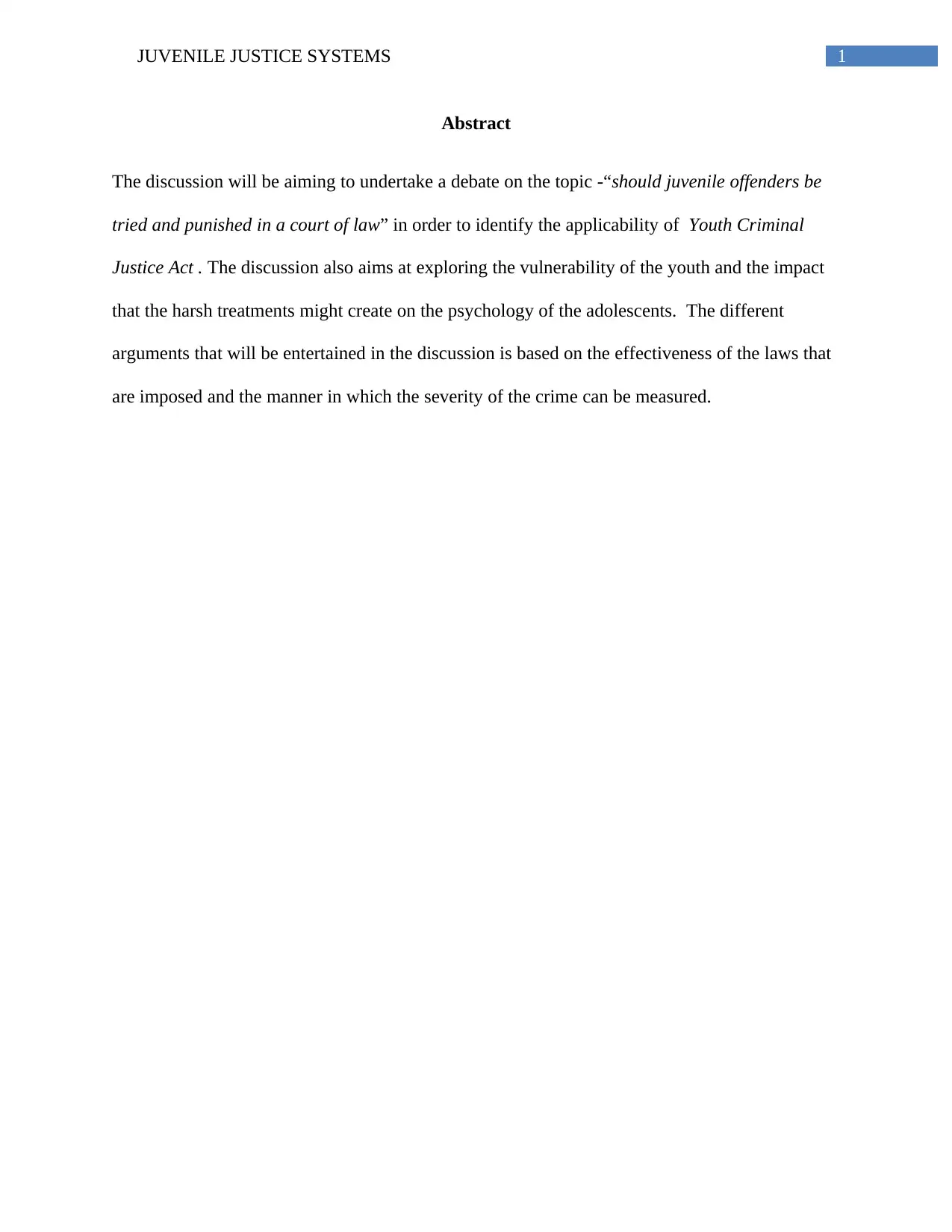
1JUVENILE JUSTICE SYSTEMS
Abstract
The discussion will be aiming to undertake a debate on the topic -“should juvenile offenders be
tried and punished in a court of law” in order to identify the applicability of Youth Criminal
Justice Act . The discussion also aims at exploring the vulnerability of the youth and the impact
that the harsh treatments might create on the psychology of the adolescents. The different
arguments that will be entertained in the discussion is based on the effectiveness of the laws that
are imposed and the manner in which the severity of the crime can be measured.
Abstract
The discussion will be aiming to undertake a debate on the topic -“should juvenile offenders be
tried and punished in a court of law” in order to identify the applicability of Youth Criminal
Justice Act . The discussion also aims at exploring the vulnerability of the youth and the impact
that the harsh treatments might create on the psychology of the adolescents. The different
arguments that will be entertained in the discussion is based on the effectiveness of the laws that
are imposed and the manner in which the severity of the crime can be measured.
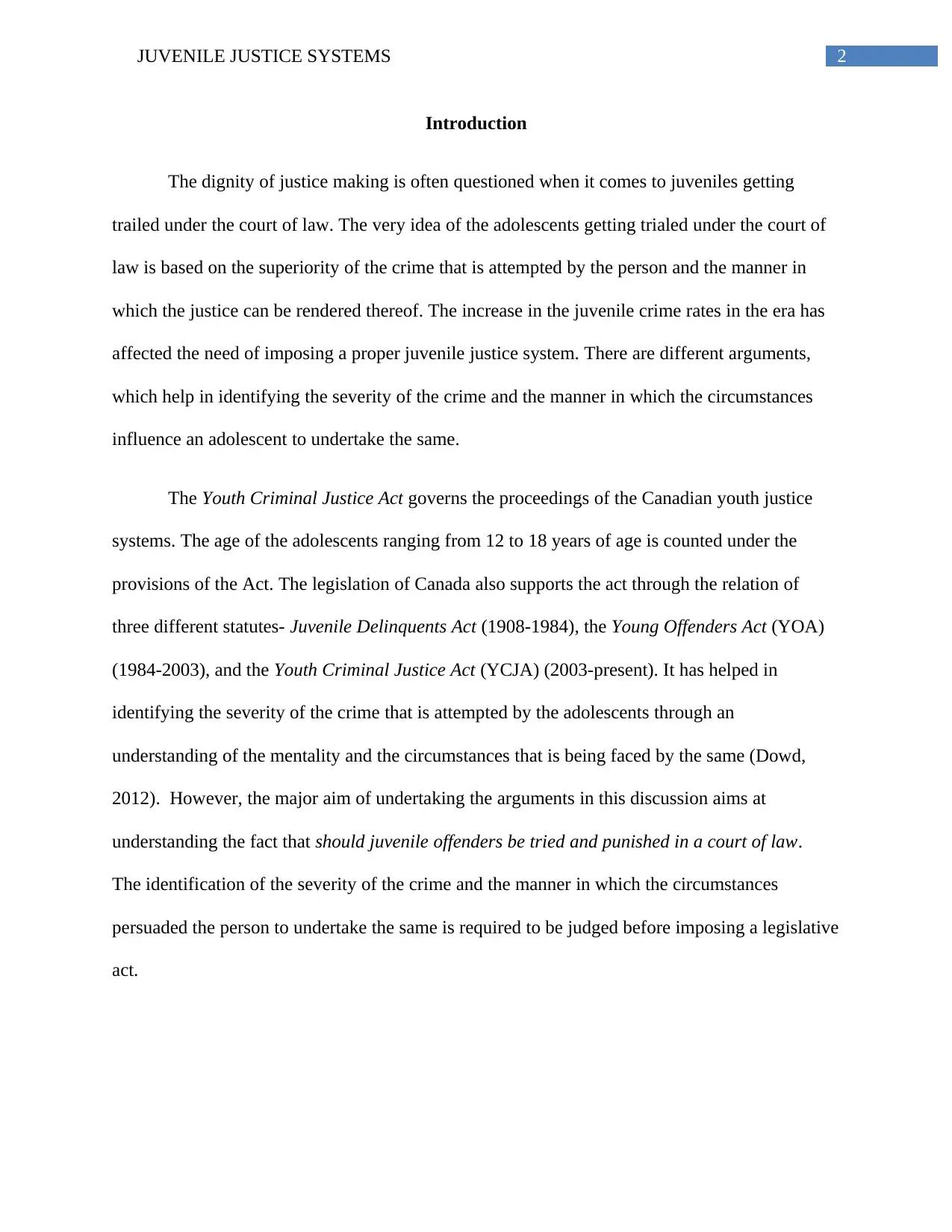
2JUVENILE JUSTICE SYSTEMS
Introduction
The dignity of justice making is often questioned when it comes to juveniles getting
trailed under the court of law. The very idea of the adolescents getting trialed under the court of
law is based on the superiority of the crime that is attempted by the person and the manner in
which the justice can be rendered thereof. The increase in the juvenile crime rates in the era has
affected the need of imposing a proper juvenile justice system. There are different arguments,
which help in identifying the severity of the crime and the manner in which the circumstances
influence an adolescent to undertake the same.
The Youth Criminal Justice Act governs the proceedings of the Canadian youth justice
systems. The age of the adolescents ranging from 12 to 18 years of age is counted under the
provisions of the Act. The legislation of Canada also supports the act through the relation of
three different statutes- Juvenile Delinquents Act (1908-1984), the Young Offenders Act (YOA)
(1984-2003), and the Youth Criminal Justice Act (YCJA) (2003-present). It has helped in
identifying the severity of the crime that is attempted by the adolescents through an
understanding of the mentality and the circumstances that is being faced by the same (Dowd,
2012). However, the major aim of undertaking the arguments in this discussion aims at
understanding the fact that should juvenile offenders be tried and punished in a court of law.
The identification of the severity of the crime and the manner in which the circumstances
persuaded the person to undertake the same is required to be judged before imposing a legislative
act.
Introduction
The dignity of justice making is often questioned when it comes to juveniles getting
trailed under the court of law. The very idea of the adolescents getting trialed under the court of
law is based on the superiority of the crime that is attempted by the person and the manner in
which the justice can be rendered thereof. The increase in the juvenile crime rates in the era has
affected the need of imposing a proper juvenile justice system. There are different arguments,
which help in identifying the severity of the crime and the manner in which the circumstances
influence an adolescent to undertake the same.
The Youth Criminal Justice Act governs the proceedings of the Canadian youth justice
systems. The age of the adolescents ranging from 12 to 18 years of age is counted under the
provisions of the Act. The legislation of Canada also supports the act through the relation of
three different statutes- Juvenile Delinquents Act (1908-1984), the Young Offenders Act (YOA)
(1984-2003), and the Youth Criminal Justice Act (YCJA) (2003-present). It has helped in
identifying the severity of the crime that is attempted by the adolescents through an
understanding of the mentality and the circumstances that is being faced by the same (Dowd,
2012). However, the major aim of undertaking the arguments in this discussion aims at
understanding the fact that should juvenile offenders be tried and punished in a court of law.
The identification of the severity of the crime and the manner in which the circumstances
persuaded the person to undertake the same is required to be judged before imposing a legislative
act.
⊘ This is a preview!⊘
Do you want full access?
Subscribe today to unlock all pages.

Trusted by 1+ million students worldwide
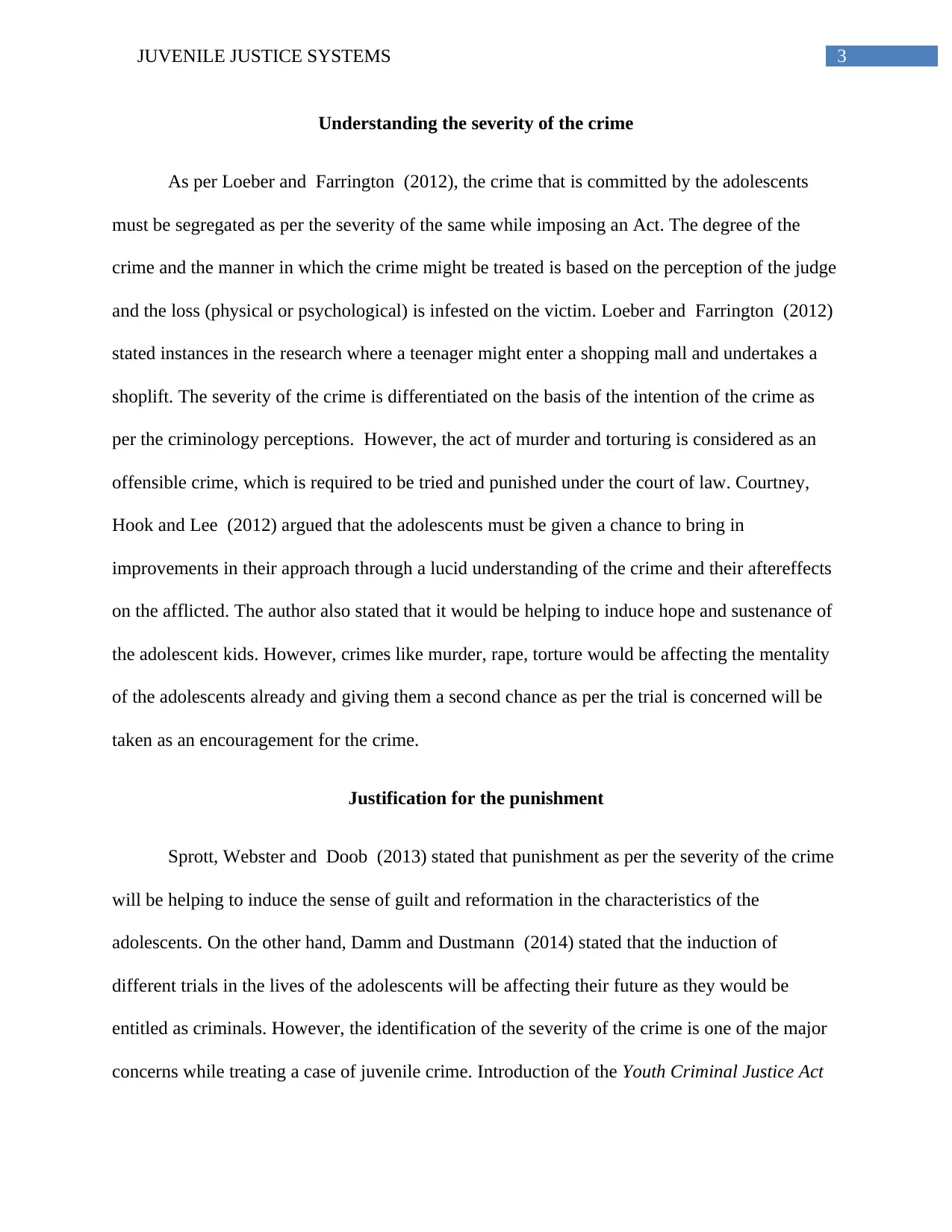
3JUVENILE JUSTICE SYSTEMS
Understanding the severity of the crime
As per Loeber and Farrington (2012), the crime that is committed by the adolescents
must be segregated as per the severity of the same while imposing an Act. The degree of the
crime and the manner in which the crime might be treated is based on the perception of the judge
and the loss (physical or psychological) is infested on the victim. Loeber and Farrington (2012)
stated instances in the research where a teenager might enter a shopping mall and undertakes a
shoplift. The severity of the crime is differentiated on the basis of the intention of the crime as
per the criminology perceptions. However, the act of murder and torturing is considered as an
offensible crime, which is required to be tried and punished under the court of law. Courtney,
Hook and Lee (2012) argued that the adolescents must be given a chance to bring in
improvements in their approach through a lucid understanding of the crime and their aftereffects
on the afflicted. The author also stated that it would be helping to induce hope and sustenance of
the adolescent kids. However, crimes like murder, rape, torture would be affecting the mentality
of the adolescents already and giving them a second chance as per the trial is concerned will be
taken as an encouragement for the crime.
Justification for the punishment
Sprott, Webster and Doob (2013) stated that punishment as per the severity of the crime
will be helping to induce the sense of guilt and reformation in the characteristics of the
adolescents. On the other hand, Damm and Dustmann (2014) stated that the induction of
different trials in the lives of the adolescents will be affecting their future as they would be
entitled as criminals. However, the identification of the severity of the crime is one of the major
concerns while treating a case of juvenile crime. Introduction of the Youth Criminal Justice Act
Understanding the severity of the crime
As per Loeber and Farrington (2012), the crime that is committed by the adolescents
must be segregated as per the severity of the same while imposing an Act. The degree of the
crime and the manner in which the crime might be treated is based on the perception of the judge
and the loss (physical or psychological) is infested on the victim. Loeber and Farrington (2012)
stated instances in the research where a teenager might enter a shopping mall and undertakes a
shoplift. The severity of the crime is differentiated on the basis of the intention of the crime as
per the criminology perceptions. However, the act of murder and torturing is considered as an
offensible crime, which is required to be tried and punished under the court of law. Courtney,
Hook and Lee (2012) argued that the adolescents must be given a chance to bring in
improvements in their approach through a lucid understanding of the crime and their aftereffects
on the afflicted. The author also stated that it would be helping to induce hope and sustenance of
the adolescent kids. However, crimes like murder, rape, torture would be affecting the mentality
of the adolescents already and giving them a second chance as per the trial is concerned will be
taken as an encouragement for the crime.
Justification for the punishment
Sprott, Webster and Doob (2013) stated that punishment as per the severity of the crime
will be helping to induce the sense of guilt and reformation in the characteristics of the
adolescents. On the other hand, Damm and Dustmann (2014) stated that the induction of
different trials in the lives of the adolescents will be affecting their future as they would be
entitled as criminals. However, the identification of the severity of the crime is one of the major
concerns while treating a case of juvenile crime. Introduction of the Youth Criminal Justice Act
Paraphrase This Document
Need a fresh take? Get an instant paraphrase of this document with our AI Paraphraser
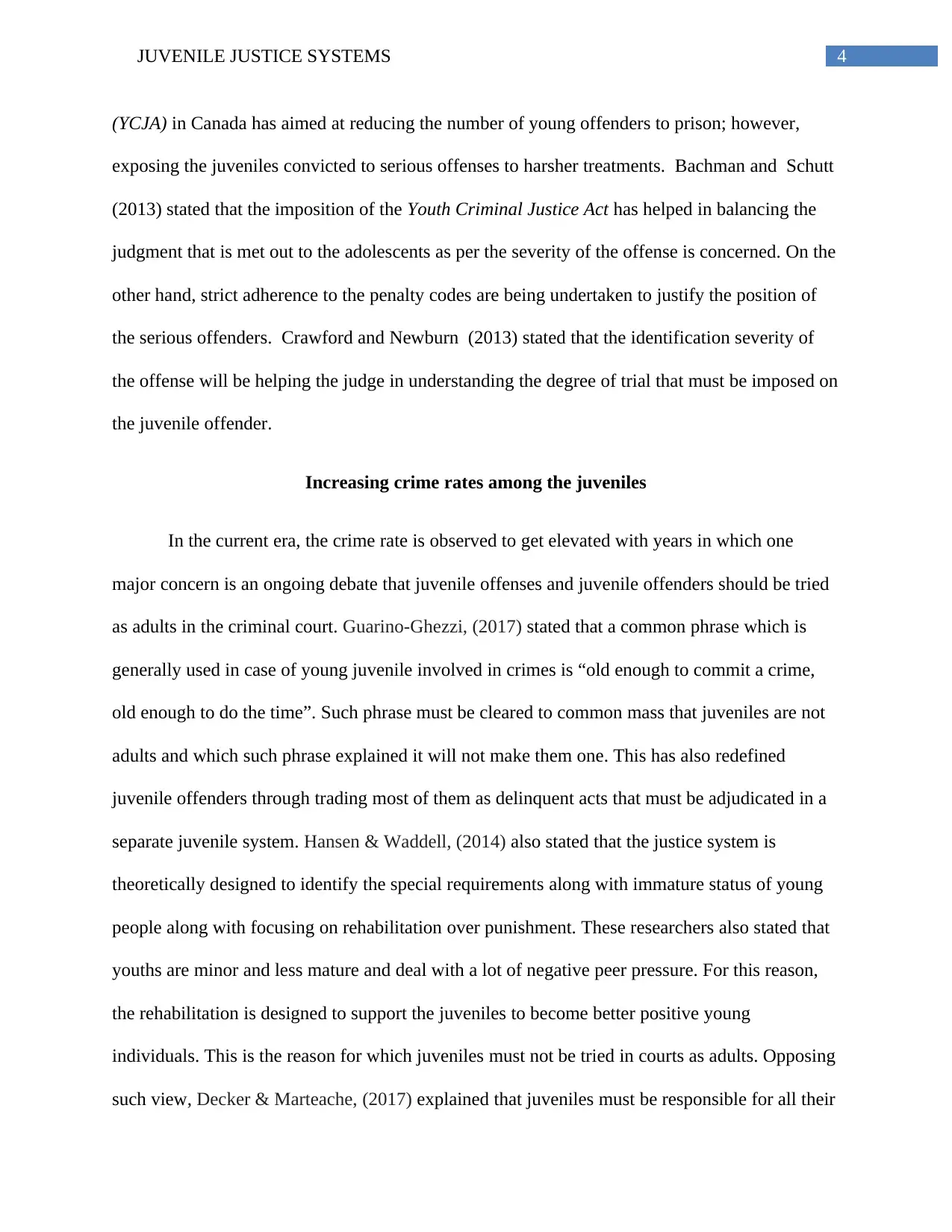
4JUVENILE JUSTICE SYSTEMS
(YCJA) in Canada has aimed at reducing the number of young offenders to prison; however,
exposing the juveniles convicted to serious offenses to harsher treatments. Bachman and Schutt
(2013) stated that the imposition of the Youth Criminal Justice Act has helped in balancing the
judgment that is met out to the adolescents as per the severity of the offense is concerned. On the
other hand, strict adherence to the penalty codes are being undertaken to justify the position of
the serious offenders. Crawford and Newburn (2013) stated that the identification severity of
the offense will be helping the judge in understanding the degree of trial that must be imposed on
the juvenile offender.
Increasing crime rates among the juveniles
In the current era, the crime rate is observed to get elevated with years in which one
major concern is an ongoing debate that juvenile offenses and juvenile offenders should be tried
as adults in the criminal court. Guarino-Ghezzi, (2017) stated that a common phrase which is
generally used in case of young juvenile involved in crimes is “old enough to commit a crime,
old enough to do the time”. Such phrase must be cleared to common mass that juveniles are not
adults and which such phrase explained it will not make them one. This has also redefined
juvenile offenders through trading most of them as delinquent acts that must be adjudicated in a
separate juvenile system. Hansen & Waddell, (2014) also stated that the justice system is
theoretically designed to identify the special requirements along with immature status of young
people along with focusing on rehabilitation over punishment. These researchers also stated that
youths are minor and less mature and deal with a lot of negative peer pressure. For this reason,
the rehabilitation is designed to support the juveniles to become better positive young
individuals. This is the reason for which juveniles must not be tried in courts as adults. Opposing
such view, Decker & Marteache, (2017) explained that juveniles must be responsible for all their
(YCJA) in Canada has aimed at reducing the number of young offenders to prison; however,
exposing the juveniles convicted to serious offenses to harsher treatments. Bachman and Schutt
(2013) stated that the imposition of the Youth Criminal Justice Act has helped in balancing the
judgment that is met out to the adolescents as per the severity of the offense is concerned. On the
other hand, strict adherence to the penalty codes are being undertaken to justify the position of
the serious offenders. Crawford and Newburn (2013) stated that the identification severity of
the offense will be helping the judge in understanding the degree of trial that must be imposed on
the juvenile offender.
Increasing crime rates among the juveniles
In the current era, the crime rate is observed to get elevated with years in which one
major concern is an ongoing debate that juvenile offenses and juvenile offenders should be tried
as adults in the criminal court. Guarino-Ghezzi, (2017) stated that a common phrase which is
generally used in case of young juvenile involved in crimes is “old enough to commit a crime,
old enough to do the time”. Such phrase must be cleared to common mass that juveniles are not
adults and which such phrase explained it will not make them one. This has also redefined
juvenile offenders through trading most of them as delinquent acts that must be adjudicated in a
separate juvenile system. Hansen & Waddell, (2014) also stated that the justice system is
theoretically designed to identify the special requirements along with immature status of young
people along with focusing on rehabilitation over punishment. These researchers also stated that
youths are minor and less mature and deal with a lot of negative peer pressure. For this reason,
the rehabilitation is designed to support the juveniles to become better positive young
individuals. This is the reason for which juveniles must not be tried in courts as adults. Opposing
such view, Decker & Marteache, (2017) explained that juveniles must be responsible for all their
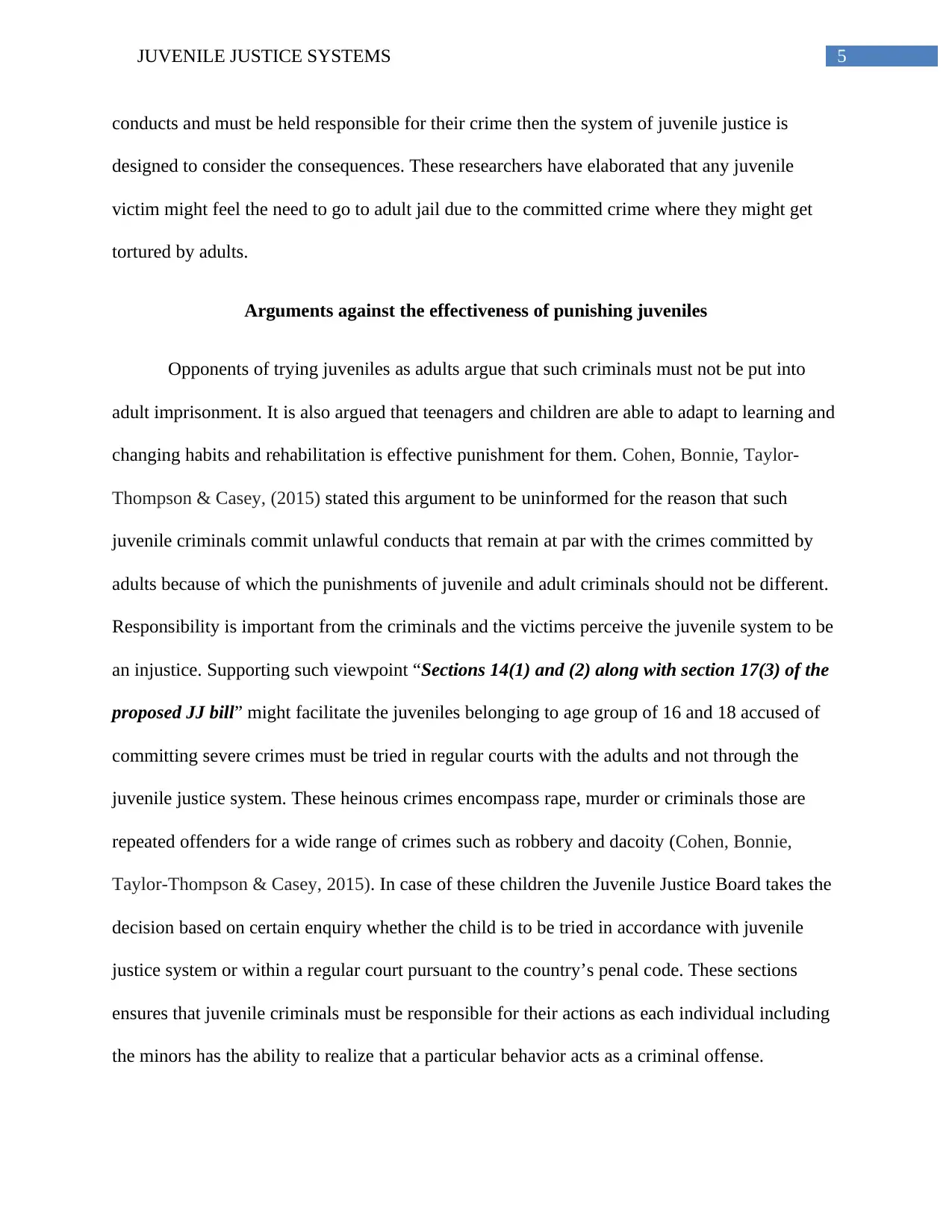
5JUVENILE JUSTICE SYSTEMS
conducts and must be held responsible for their crime then the system of juvenile justice is
designed to consider the consequences. These researchers have elaborated that any juvenile
victim might feel the need to go to adult jail due to the committed crime where they might get
tortured by adults.
Arguments against the effectiveness of punishing juveniles
Opponents of trying juveniles as adults argue that such criminals must not be put into
adult imprisonment. It is also argued that teenagers and children are able to adapt to learning and
changing habits and rehabilitation is effective punishment for them. Cohen, Bonnie, Taylor-
Thompson & Casey, (2015) stated this argument to be uninformed for the reason that such
juvenile criminals commit unlawful conducts that remain at par with the crimes committed by
adults because of which the punishments of juvenile and adult criminals should not be different.
Responsibility is important from the criminals and the victims perceive the juvenile system to be
an injustice. Supporting such viewpoint “Sections 14(1) and (2) along with section 17(3) of the
proposed JJ bill” might facilitate the juveniles belonging to age group of 16 and 18 accused of
committing severe crimes must be tried in regular courts with the adults and not through the
juvenile justice system. These heinous crimes encompass rape, murder or criminals those are
repeated offenders for a wide range of crimes such as robbery and dacoity (Cohen, Bonnie,
Taylor-Thompson & Casey, 2015). In case of these children the Juvenile Justice Board takes the
decision based on certain enquiry whether the child is to be tried in accordance with juvenile
justice system or within a regular court pursuant to the country’s penal code. These sections
ensures that juvenile criminals must be responsible for their actions as each individual including
the minors has the ability to realize that a particular behavior acts as a criminal offense.
conducts and must be held responsible for their crime then the system of juvenile justice is
designed to consider the consequences. These researchers have elaborated that any juvenile
victim might feel the need to go to adult jail due to the committed crime where they might get
tortured by adults.
Arguments against the effectiveness of punishing juveniles
Opponents of trying juveniles as adults argue that such criminals must not be put into
adult imprisonment. It is also argued that teenagers and children are able to adapt to learning and
changing habits and rehabilitation is effective punishment for them. Cohen, Bonnie, Taylor-
Thompson & Casey, (2015) stated this argument to be uninformed for the reason that such
juvenile criminals commit unlawful conducts that remain at par with the crimes committed by
adults because of which the punishments of juvenile and adult criminals should not be different.
Responsibility is important from the criminals and the victims perceive the juvenile system to be
an injustice. Supporting such viewpoint “Sections 14(1) and (2) along with section 17(3) of the
proposed JJ bill” might facilitate the juveniles belonging to age group of 16 and 18 accused of
committing severe crimes must be tried in regular courts with the adults and not through the
juvenile justice system. These heinous crimes encompass rape, murder or criminals those are
repeated offenders for a wide range of crimes such as robbery and dacoity (Cohen, Bonnie,
Taylor-Thompson & Casey, 2015). In case of these children the Juvenile Justice Board takes the
decision based on certain enquiry whether the child is to be tried in accordance with juvenile
justice system or within a regular court pursuant to the country’s penal code. These sections
ensures that juvenile criminals must be responsible for their actions as each individual including
the minors has the ability to realize that a particular behavior acts as a criminal offense.
⊘ This is a preview!⊘
Do you want full access?
Subscribe today to unlock all pages.

Trusted by 1+ million students worldwide
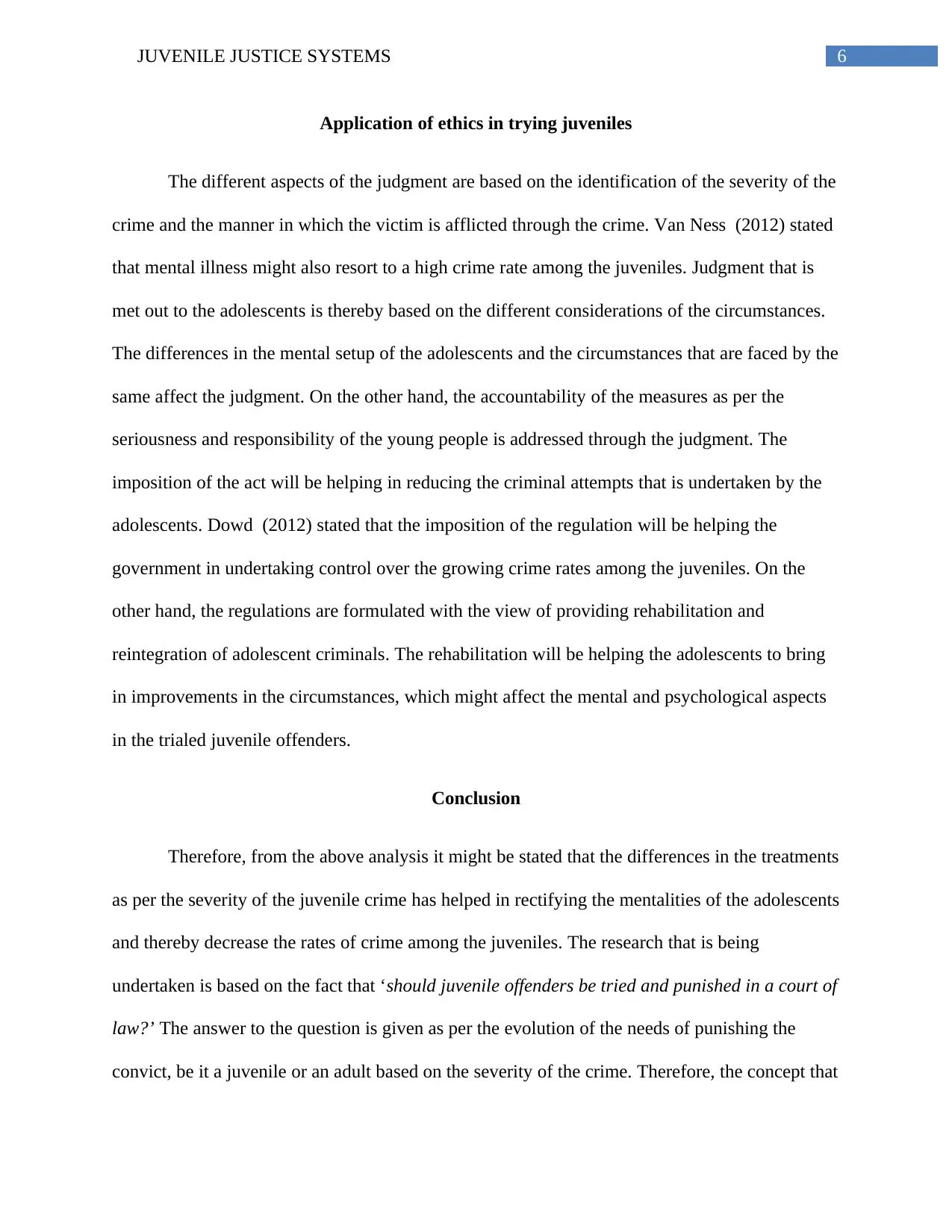
6JUVENILE JUSTICE SYSTEMS
Application of ethics in trying juveniles
The different aspects of the judgment are based on the identification of the severity of the
crime and the manner in which the victim is afflicted through the crime. Van Ness (2012) stated
that mental illness might also resort to a high crime rate among the juveniles. Judgment that is
met out to the adolescents is thereby based on the different considerations of the circumstances.
The differences in the mental setup of the adolescents and the circumstances that are faced by the
same affect the judgment. On the other hand, the accountability of the measures as per the
seriousness and responsibility of the young people is addressed through the judgment. The
imposition of the act will be helping in reducing the criminal attempts that is undertaken by the
adolescents. Dowd (2012) stated that the imposition of the regulation will be helping the
government in undertaking control over the growing crime rates among the juveniles. On the
other hand, the regulations are formulated with the view of providing rehabilitation and
reintegration of adolescent criminals. The rehabilitation will be helping the adolescents to bring
in improvements in the circumstances, which might affect the mental and psychological aspects
in the trialed juvenile offenders.
Conclusion
Therefore, from the above analysis it might be stated that the differences in the treatments
as per the severity of the juvenile crime has helped in rectifying the mentalities of the adolescents
and thereby decrease the rates of crime among the juveniles. The research that is being
undertaken is based on the fact that ‘should juvenile offenders be tried and punished in a court of
law?’ The answer to the question is given as per the evolution of the needs of punishing the
convict, be it a juvenile or an adult based on the severity of the crime. Therefore, the concept that
Application of ethics in trying juveniles
The different aspects of the judgment are based on the identification of the severity of the
crime and the manner in which the victim is afflicted through the crime. Van Ness (2012) stated
that mental illness might also resort to a high crime rate among the juveniles. Judgment that is
met out to the adolescents is thereby based on the different considerations of the circumstances.
The differences in the mental setup of the adolescents and the circumstances that are faced by the
same affect the judgment. On the other hand, the accountability of the measures as per the
seriousness and responsibility of the young people is addressed through the judgment. The
imposition of the act will be helping in reducing the criminal attempts that is undertaken by the
adolescents. Dowd (2012) stated that the imposition of the regulation will be helping the
government in undertaking control over the growing crime rates among the juveniles. On the
other hand, the regulations are formulated with the view of providing rehabilitation and
reintegration of adolescent criminals. The rehabilitation will be helping the adolescents to bring
in improvements in the circumstances, which might affect the mental and psychological aspects
in the trialed juvenile offenders.
Conclusion
Therefore, from the above analysis it might be stated that the differences in the treatments
as per the severity of the juvenile crime has helped in rectifying the mentalities of the adolescents
and thereby decrease the rates of crime among the juveniles. The research that is being
undertaken is based on the fact that ‘should juvenile offenders be tried and punished in a court of
law?’ The answer to the question is given as per the evolution of the needs of punishing the
convict, be it a juvenile or an adult based on the severity of the crime. Therefore, the concept that
Paraphrase This Document
Need a fresh take? Get an instant paraphrase of this document with our AI Paraphraser
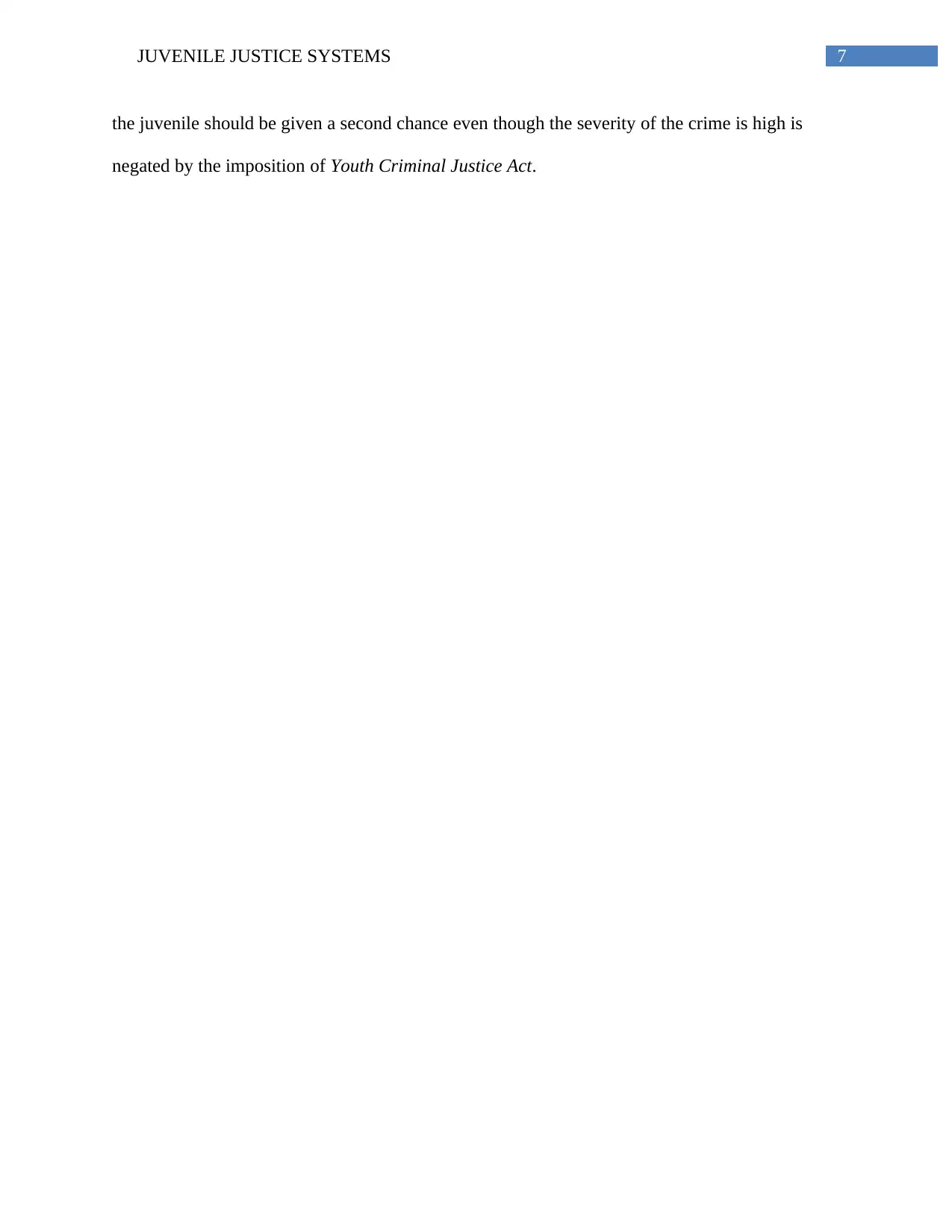
7JUVENILE JUSTICE SYSTEMS
the juvenile should be given a second chance even though the severity of the crime is high is
negated by the imposition of Youth Criminal Justice Act.
the juvenile should be given a second chance even though the severity of the crime is high is
negated by the imposition of Youth Criminal Justice Act.
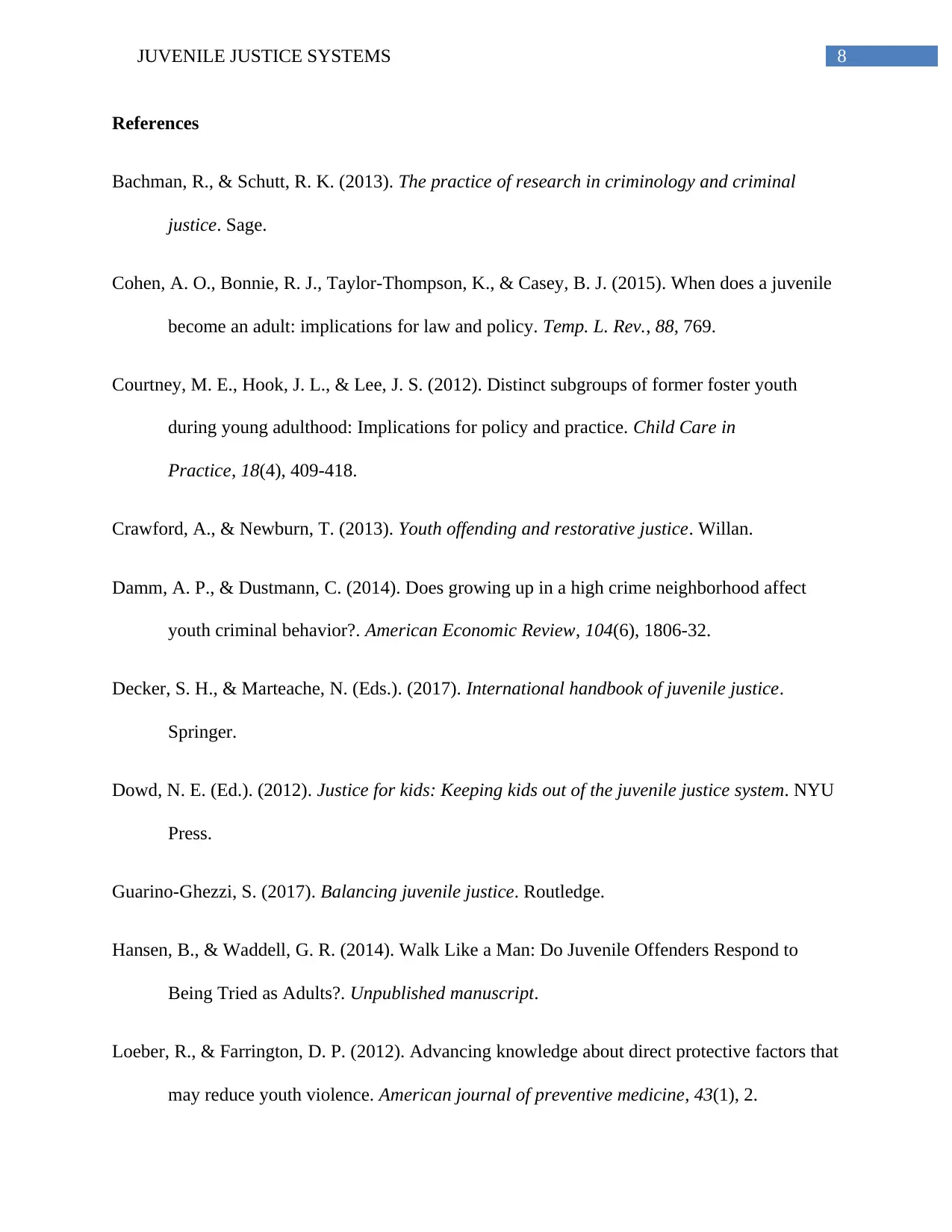
8JUVENILE JUSTICE SYSTEMS
References
Bachman, R., & Schutt, R. K. (2013). The practice of research in criminology and criminal
justice. Sage.
Cohen, A. O., Bonnie, R. J., Taylor-Thompson, K., & Casey, B. J. (2015). When does a juvenile
become an adult: implications for law and policy. Temp. L. Rev., 88, 769.
Courtney, M. E., Hook, J. L., & Lee, J. S. (2012). Distinct subgroups of former foster youth
during young adulthood: Implications for policy and practice. Child Care in
Practice, 18(4), 409-418.
Crawford, A., & Newburn, T. (2013). Youth offending and restorative justice. Willan.
Damm, A. P., & Dustmann, C. (2014). Does growing up in a high crime neighborhood affect
youth criminal behavior?. American Economic Review, 104(6), 1806-32.
Decker, S. H., & Marteache, N. (Eds.). (2017). International handbook of juvenile justice.
Springer.
Dowd, N. E. (Ed.). (2012). Justice for kids: Keeping kids out of the juvenile justice system. NYU
Press.
Guarino-Ghezzi, S. (2017). Balancing juvenile justice. Routledge.
Hansen, B., & Waddell, G. R. (2014). Walk Like a Man: Do Juvenile Offenders Respond to
Being Tried as Adults?. Unpublished manuscript.
Loeber, R., & Farrington, D. P. (2012). Advancing knowledge about direct protective factors that
may reduce youth violence. American journal of preventive medicine, 43(1), 2.
References
Bachman, R., & Schutt, R. K. (2013). The practice of research in criminology and criminal
justice. Sage.
Cohen, A. O., Bonnie, R. J., Taylor-Thompson, K., & Casey, B. J. (2015). When does a juvenile
become an adult: implications for law and policy. Temp. L. Rev., 88, 769.
Courtney, M. E., Hook, J. L., & Lee, J. S. (2012). Distinct subgroups of former foster youth
during young adulthood: Implications for policy and practice. Child Care in
Practice, 18(4), 409-418.
Crawford, A., & Newburn, T. (2013). Youth offending and restorative justice. Willan.
Damm, A. P., & Dustmann, C. (2014). Does growing up in a high crime neighborhood affect
youth criminal behavior?. American Economic Review, 104(6), 1806-32.
Decker, S. H., & Marteache, N. (Eds.). (2017). International handbook of juvenile justice.
Springer.
Dowd, N. E. (Ed.). (2012). Justice for kids: Keeping kids out of the juvenile justice system. NYU
Press.
Guarino-Ghezzi, S. (2017). Balancing juvenile justice. Routledge.
Hansen, B., & Waddell, G. R. (2014). Walk Like a Man: Do Juvenile Offenders Respond to
Being Tried as Adults?. Unpublished manuscript.
Loeber, R., & Farrington, D. P. (2012). Advancing knowledge about direct protective factors that
may reduce youth violence. American journal of preventive medicine, 43(1), 2.
⊘ This is a preview!⊘
Do you want full access?
Subscribe today to unlock all pages.

Trusted by 1+ million students worldwide
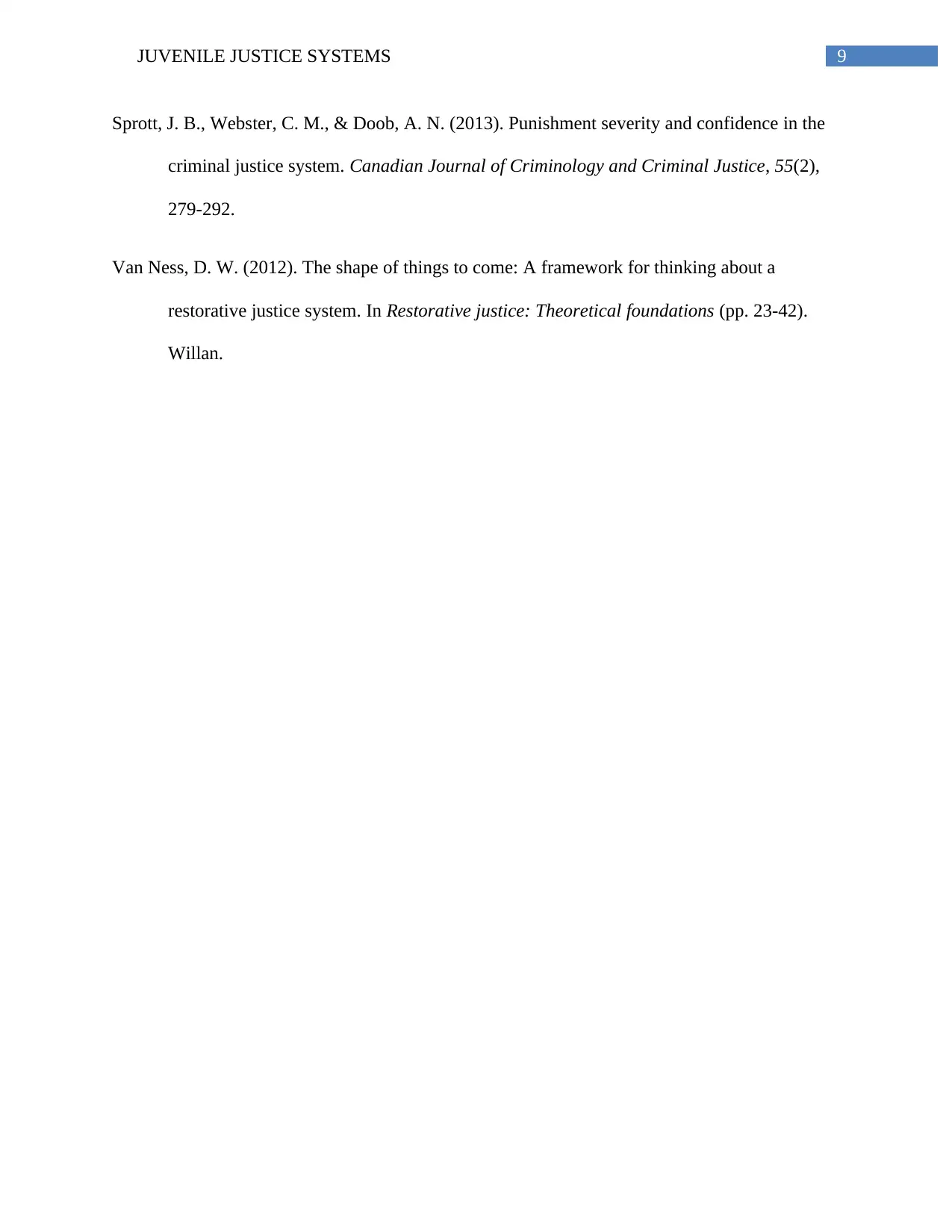
9JUVENILE JUSTICE SYSTEMS
Sprott, J. B., Webster, C. M., & Doob, A. N. (2013). Punishment severity and confidence in the
criminal justice system. Canadian Journal of Criminology and Criminal Justice, 55(2),
279-292.
Van Ness, D. W. (2012). The shape of things to come: A framework for thinking about a
restorative justice system. In Restorative justice: Theoretical foundations (pp. 23-42).
Willan.
Sprott, J. B., Webster, C. M., & Doob, A. N. (2013). Punishment severity and confidence in the
criminal justice system. Canadian Journal of Criminology and Criminal Justice, 55(2),
279-292.
Van Ness, D. W. (2012). The shape of things to come: A framework for thinking about a
restorative justice system. In Restorative justice: Theoretical foundations (pp. 23-42).
Willan.
1 out of 10
Related Documents
Your All-in-One AI-Powered Toolkit for Academic Success.
+13062052269
info@desklib.com
Available 24*7 on WhatsApp / Email
![[object Object]](/_next/static/media/star-bottom.7253800d.svg)
Unlock your academic potential
Copyright © 2020–2025 A2Z Services. All Rights Reserved. Developed and managed by ZUCOL.




